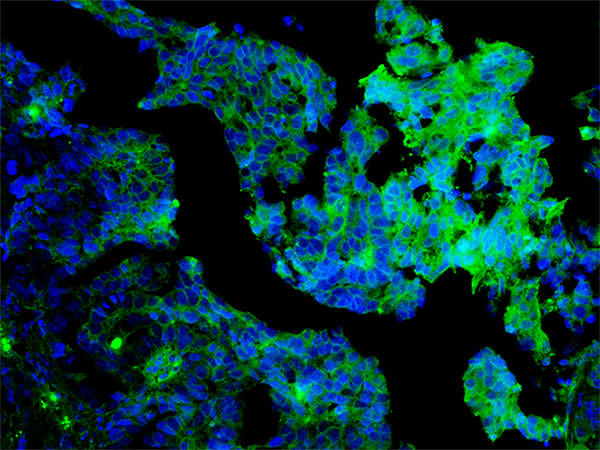New Strategy for Treating Advanced Ovarian Cancer Shows Promise in Mice
, by NCI Staff
An experimental strategy for treating advanced ovarian cancer has caused tumor regression in animal models, according to a new study. The strategy uses a protein fragment, or peptide, to stimulate normal cells in the tissues surrounding cancer cells—the tumor microenvironment—to block the growth of the cancer cells.
Suming Wang, Ph.D., and Anna Blois, Ph.D., of Boston Children’s Hospital’s Vascular Biology Program and their colleagues, reported the results March 9 in Science Translational Medicine. Based on the findings, the researchers said they would continue to explore this strategy as a potential treatment for ovarian cancer that has spread to other parts of the body, or metastasized.
New treatments are needed for metastatic ovarian cancer, noted Randolph Watnick, Ph.D., of Boston Children’s Hospital, who led the study. Although some patients benefit from surgery and chemotherapy, most ovarian tumors develop genetic changes that eventually cause chemotherapy to stop working, leaving patients with few treatment options.
Targeting the Microenvironment
The new study builds on more than a decade of work in Dr. Watnick’s laboratory to understand how tumors interact with their microenvironments. A long-term goal has been to find ways to stimulate noncancerous cells in the tumor microenvironment to shrink, or stabilize, tumors, thereby preventing the cancer from spreading.
In 2009, his team reported that a protein called prosaposin could prevent metastases in animal models of human prostate and breast cancers. This protein stimulates immune cells called monocytes, which are recruited to metastatic sites from bone marrow, to produce a protein called thrombospondin-1.
These bone marrow-derived monocytes, also referred to as myeloid-derived suppressor cells (MDSCs), stimulate tumor growth by suppressing the function of immune cells. Thus, by targeting MDSCs, the peptide has the potential to also block the suppression of T cells which could further add to its ability to inhibit tumor growth, the researchers reported in 2013.
Thrombospondin-1 normally plays a role in controlling the tissue response to injury. In animal models of cancer, thrombospondin-1 blocks the growth of metastatic tumors in two ways: by inhibiting the formation of new blood vessels that tumors need to grow beyond a certain size and by stimulating immune cells to kill tumor cells.
For the current study, the researchers identified the segment of prosaposin that stimulates thrombospondin-1 and created a modified version of the peptide for use as a potential drug. They tested the peptide in mice with tumors formed by transplanted human ovarian cancer cells.
“We found that the peptide could not only stop the progression of the tumors but could also shrink tumors to an undetectable state, which was very exciting,” said Dr. Watnick.
In general, bioactive peptides are poor drugs due to their instability, but the authors of this study have created a cyclic peptide that appears to overcome this issue, noted David Roberts, Ph.D., of NCI’s Center for Cancer Research who studies thrombospondin-1 but was not involved in the research.
“The cyclic peptide is a novel experimental therapeutic that merits further study,” Dr. Roberts added.
Investigating Biological Mechanisms
In the mice, the peptide triggered the death of ovarian cancer cells that expressed a receptor protein called CD36, which interacts with thrombospondin-1. Based on this finding, the researchers profiled CD36 levels in tissue samples and tumor samples from patients with metastatic ovarian cancer to assess how broadly applicable the peptide-based therapy might be.
An analysis of samples from 134 patients showed that 97 percent of the primary tumors expressed CD36, compared with 61 percent of normal tissues. CD36 levels were also higher in metastatic tumors than in primary tumors. The association of CD36 levels with extent of disease provides a further rationale for continuing to develop the peptide, the study authors noted.
Dr. Roberts’ lab and other researchers have recently identified a different thrombospondin-1 receptor that may mediate the direct killing of cancer cells. This receptor, CD47, also forces tumor-initiating cells, sometimes called cancer stem cells, to differentiate into mature cells, Dr. Roberts explained.
Therefore, he continued, a drug that increases the expression of thrombospondin-1 in the tumor microenvironment “could have multiple beneficial effects.”
Dr. Watnick added that the new strategy might have another advantage for patients: Tumors might be less likely to develop resistance to treatments that target their microenvironments rather than the tumors themselves. Tumors often develop genetic changes that can cause them to stop responding to previously effective treatments.
“By targeting cells in the microenvironment rather than the tumors, it might be possible to significantly mitigate or avoid the problem of resistance,” Dr. Watnick said.
